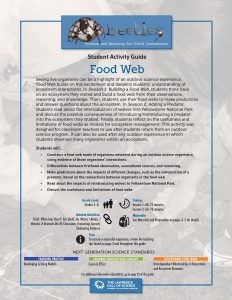Seeing live organisms can be a highlight of an outdoor science experience. Food Web builds on this excitement and deepens students’ understanding of ecosystem interactions. In Session 1: Building a Food Web, students think back on an ecosystem they visited and build a food web from their observations, reasoning, and knowledge. Then, students use their food webs to make predictions and answer questions about the ecosystem. In Session 2: Adding a Predator, students read about the reintroduction of wolves into Yellowstone National Park and discuss the possible consequences of introducing/reintroducing a predator into the ecosystem they studied. Finally, students reflect on the usefulness and limitations of food webs as models for ecosystem management. This activity was designed for classroom teachers to use after students return from an outdoor science program. It can also be used after any outdoor experience in which students observed many organisms within an ecosystem.
Students will:
- Construct a food web made of organisms observed during an outdoor science experience, using evidence of those organisms’ interactions.
- Differentiate between firsthand observation, secondhand sources, and reasoning.
- Make predictions about the impacts of different changes, such as the introduction of a predator, based on the connections between organisms in the food web.
- Read about the impacts of reintroducing wolves to Yellowstone National Park.
- Discuss the usefulness and limitations of food webs.

